B0041VYHGW EBOK (49 page)
Authors: David Bordwell,Kristin Thompson

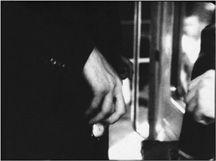
4.52 Robert Bresson’s
Pickpocket.
There are two basic types of shadows, each of which is important in film composition:
attached
shadows, or
shading,
and
cast
shadows. An attached shadow occurs when light fails to illuminate part of an object because of the object’s shape or surface features. If a person sits by a candle in a darkened room, patches of the face and body will fall into darkness. Most obviously, the nose often creates a patch of darkness on an adjoining cheek. This phenomenon is shading, or attached shadow. But the candle also projects a shadow on the wall behind. This is a cast shadow, because the body blocks out the light. The shadows in
4.51
, for example, are cast shadows, made by bars between the actor and the light source. But in
4.52
, the small, dark patches on the hand are attached shadows, for they are caused by the three-dimensional curves and ridges of the hand itself.
As these examples suggest, highlights and shadows help create our sense of a scene’s space. In
4.51
, a few shadows imply an entire prison cell. Lighting also shapes a shot’s overall composition. One shot from John Huston’s
Asphalt Jungle
welds the gang members into a unit by the pool of light cast by a hanging lamp
(
4.53
).
At the same time, it sets up a scale of importance, emphasizing the protagonist by making him the most frontal and clearly lit figure.
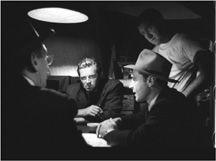
4.53 Attached shadows on faces create a dramatic composition in John Huston’s
Asphalt Jungle.
A shot’s lighting affects our sense of the shape and texture of the objects depicted. If a ball is lit straight on from the front, it appears round. If the same ball is lit from the side, we see it as a half-circle. Hollis Frampton’s short film
Lemon
consists primarily of light moving around a lemon, and the shifting shadows create dramatically changing patterns of yellow and black. This film almost seems designed to prove the truth of a remark made by Josef von Sternberg, one of the cinema’s masters of film lighting: “The proper use of light can embellish and dramatize every object.”
“Light is everything. It expresses ideology, emotion, colour, depth, style. It can efface, narrate, describe. With the right lighting, the ugliest face, the most idiotic expression can radiate with beauty or intelligence.”
— Frederico Fellini, director
For our purposes, we can isolate four major features of film lighting: its quality, direction, source, and color.
Lighting
quality
refers to the relative intensity of the illumination.
Hard
lighting creates clearly defined shadows, crisp textures, and sharp edges, whereas
soft
lighting creates a diffused illumination. In nature, the noonday sun creates hard light, while an overcast sky creates soft light. The terms are relative, and many lighting situations will fall between the extremes, but we can usually recognize the differences
(
4.54
,
4.55
).
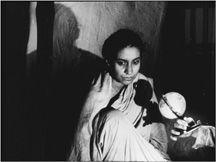
4.54 In this shot from Satyajit Ray’s
Aparajito,
Apu’s mother and the globe she holds are emphasized by hard lighting, while …
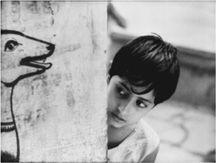
4.55 … in another shot from the same film, softer lighting blurs contours and textures and makes for more diffusion and gentler contrasts between light and shade.
The
direction
of lighting in a shot refers to the path of light from its source or sources to the object lit. For convenience we can distinguish among frontal lighting, sidelighting, backlighting, underlighting, and top lighting.
“Every light has a point where it is brightest and a point toward which it wanders to lose itself completely…. The journey of rays from that central core to the outposts of blackness is the adventure and drama of light.”
— Josef von Sternberg
Frontal lighting
can be recognized by its tendency to eliminate shadows. In
4.56
, from Jean-Luc Godard’s
La Chinoise,
the result of such frontal lighting is a fairly flat-looking image. Contrast
4.57
, from
Touch of Evil,
in which Orson Welles uses a hard
sidelight
(also called a
crosslight
) to sculpt the character’s features.
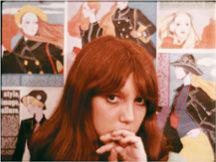
4.56 In
La Chinoise,
frontal lighting makes the actress’s shadow fall directly behind her, where we cannot see it.
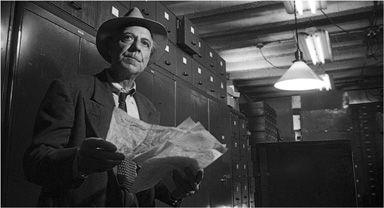
4.57 In
Touch of Evil,
sidelight creates sharp attached shadows by the character’s nose, cheek, and lips, while long cast shadows appear on the file cabinets at the left.
Backlighting
, as the name suggests, comes from behind the subject filmed. The light can be positioned at many angles: high above the figure, at various angles off to the side, pointing straight at the camera, or from below. Used with no other sources of light, backlighting tends to create silhouettes, as in
4.58
. Combined with more frontal sources of light, the technique can create an unobtrusively illuminated contour. This use of backlighting is called
edge lighting
or
rim lighting
(
4.59
).
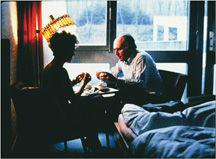
4.58 In Godard’s
Passion,
the lamp and window provide backlighting that presents the woman almost entirely in silhouette.
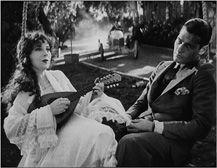
4.59 In
Wings,
a narrow line of light makes each actor’s body stand out from the background.
As its name implies,
underlighting
suggests that the light comes from below the subject. Since underlighting tends to distort features, it is often used to create dramatic horror effects, but it may also simply indicate a realistic light source, such as a fireplace, or, as in
4.60
, a flashlight. As usual, a particular technique can function differently according to context.